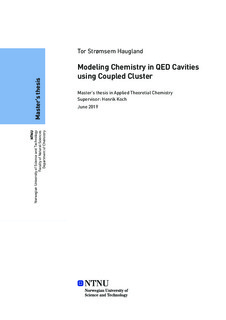| dc.contributor.advisor | Koch, Henrik | |
| dc.contributor.advisor | Kjønstad, Eirik Fadum | |
| dc.contributor.author | Haugland, Tor Strømsem | |
| dc.date.accessioned | 2019-08-25T14:05:45Z | |
| dc.date.available | 2019-08-25T14:05:45Z | |
| dc.date.issued | 2019 | |
| dc.identifier.uri | http://hdl.handle.net/11250/2610781 | |
| dc.description.abstract | I denne avhandlingen introduseres kvanteelektrodynamisk ''coupled cluster'' teori (QED-CC) som en ny og nøyaktig ab initio teori for å undersøke sterk kobling mellom lys og materie i optiske kaviteter. Ligningene for grunntilstand og eksiterte tilstander for QED-CC blir bestemt ved hjelp av Pauli-Fierz Hamiltonoperatoren og ''koherente'' fotontilstander. Kvanteelektrodynamisk Hartree-Fock teori (QED-HF) er utledet som referansebølgefunksjon for QED-CC. Ved å bruke pertubasjonsteori kan det argumenteres for at de koblede dobbelt amplitudene er små, som forenkler QED-CCSD ligningene. Vi presenterer en implementering av grunntilstander og eksiterte tilstander for QED-CCS og QED-CCSD. Ved å sammenligne disse med en eksakt referansetilstand, ser man at QED-CCSD er i stand til å reprodusere egenskaper til lys-masse systemet ved sterke koblinger for de to små testmolekylene H₂ og HF. Bruk av QED-CCSD for realistiske molekyler blir demonstrert ved å studere p-nitroanilin (PNA) i en kavitet som er i ressonans med molekylets ''charge transfer'' tilstand, som har en stor Rabi-splitting (1.22 eV) ved sterke koblinger (λ = 0.05). QED-CC åpner opp mulighetene for å undersøke nye retninger innenfor kavitet-elektrodynamikk, inkludert forståelsen av fundam entale egenskaper av koblede elektron-foton system, modifisert reaktivitet i sterk lys-materie kobling og lang-distanse effekter fra sammenfiltrerte fotoner. | |
| dc.description.abstract | In this thesis, we introduce quantum electrodynamical coupled cluster theory (QED-CC) as a new and accurate ab initio theory to investigate strong light-matter coupling in optical cavities. Starting from the Pauli-Fierz Hamiltonian in the long wavelength limit we establish the ground and excited state equations for QED-CC using coherent photon states. Quantum electrodynamical Hartree-Fock theory (QED-HF) was developed as a reference wavefunction for QED-CC. Perturbation theory is used to argue that the coupled doubles amplitudes are small, simplifying the QED-CCSD equations. We present an implementation of QED-CCS and QED-CCSD ground and excited states. A comparison to an exact reference shows that QED-CCSD reproduces the features of strong light-matter coupling for two small test molecules, H₂ and HF. We demonstrate that QED-CCSD can also be used for realistic molecules, which in our case is p-nitroaniline (PNA) in a cavity resonant with PNA's charge transfer state. The charge transfer state has a large Rabi splitting (1.22 eV) at strong couplings (λ = 0.05). QED-CC opens up the possibility of pursuing new directions in cavity quantum electrodynamics, including the understanding of the fundamentals of correlated electron-photon systems, modified reactivity in strong light-matter interaction, and long-range effects from entangled photons. | |
| dc.language | eng | |
| dc.publisher | NTNU | |
| dc.title | Modeling Chemistry in QED Cavities using Coupled Cluster | |
| dc.type | Master thesis | |
